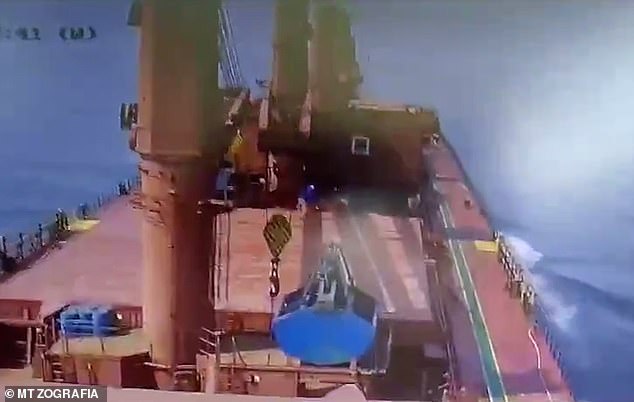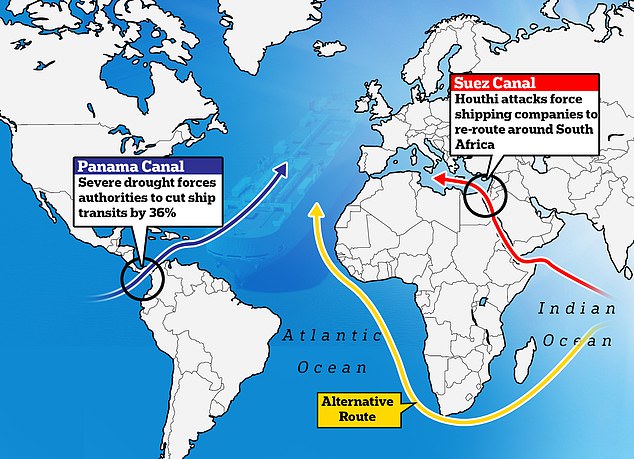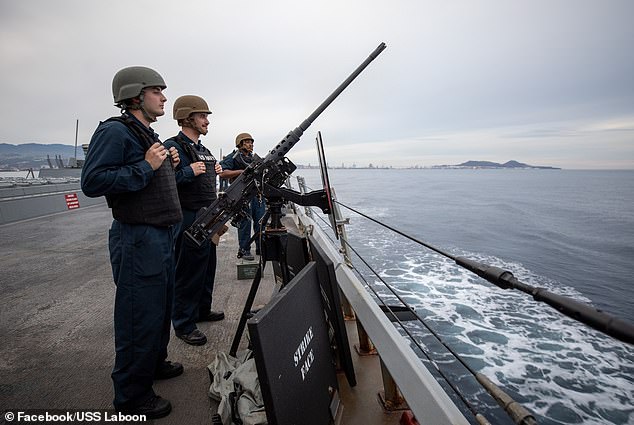Aircraft carrier fiasco as Britain REFUSES to deploy one of its £3.5 billion warships to help tackle the Houthis in Yemen: RAF jets forced to fly 3,000-mile flights as ships anchor in Portsmouth
- Britain’s two £3.5 billion aircraft carriers remain moored in Portsmouth
Former defense ministers and Royal Navy chiefs tonight expressed their dismay at Britain’s refusal to deploy one of its £3.5 billion aircraft carriers to the Red Sea.
They suggested it was absurd that Britain would continue to rely on RAF jets flying 3,000 miles from their base in Cyprus to launch air strikes against Houthi forces in Yemen.
Meanwhile, the hugely expensive aircraft carriers – ostensibly built so Britain could control the waves – have remained anchored in Portsmouth.
The Navy’s website describes HMS Queen Elizabeth and HMS Prince of Wales as ‘investments in Britain’s security, prosperity and place in the world’. Despite the rhetoric, neither airline has ever ventured near a conflict zone since they entered service.
Yesterday morning, just hours after Britain’s latest air strikes to prevent Houthis attacks on international cargo ships and tankers, the Royal Navy’s massive ships were seen idling in the calm waters off the Solent.
Calm: aircraft carriers HMS Queen Elizabeth and HMS Prince of Wales in Portsmouth harbor yesterday (photo by Steve Reigate)

A Malta-flagged MT Zografia bulk carrier, owned by Greece, was attacked in the Red Sea on Tuesday
The reason for this, the Mail has been told, is that senior government officials vetoed the Navy’s recommendation that a transporter be sent.
The decision has apparently horrified senior officers, who fear one of the airlines could be vulnerable to future defense cuts.
Speaking to the Mail, former First Sea Lord Admiral Lord West said: ‘I think it’s absolutely extraordinary that we haven’t sent a courier. As with HMS Queen Elizabeth or HMS Prince of Wales locally, we could make a much more significant contribution. Instead, we have to fly thousands of kilometers to and from Cyprus and drop a strictly limited number of nuclear warheads at great expense.
“Why did we bother building the aircraft carriers if we are apparently reluctant to deploy them operationally? This would send a very strong message to the Iranians and the Houthis. We need to plan for the medium to longer term because there is no end in sight.”
RAF Typhoons from Cyprus refueled on both legs of yesterday’s journey, as they did during the first British air raids on January 11. On Monday evening, they dropped a total of eight guided missiles at two locations near the Yemeni capital Sanaa before returning to RAF Akrotiri. .
The American F/A-18 Super Hornets involved in the joint operation took off and landed on the aircraft carrier USS Dwight D Eisenhower.
Her presence has allowed the Americans to launch eight separate airstrikes on Houthi targets in the past 10 days and provide significantly increased firepower.
According to former Defense Secretary Tobias Ellwood, the US would support the United Kingdom by sending one of its aircraft carriers to the conflict zone. He said: ‘The US would like us to send an aircraft carrier to the Middle East. We must work to prevent escalation, but prepare if it does happen – and further destabilizes the region. We have to plan four chess moves in advance.’


Images show a huge explosion at the bow of the boat flying the Malta flag

This photo from the Indian Navy shows the US ship Genco Picardy which was attacked on Wednesday by a drone carrying bombs launched by the Houthi rebels in Yemen in the Gulf of Aden, January 18, 2024

US forces launched new attacks on Iran-backed Houthi rebels in Yemen on Thursday
Another former Defense Secretary, Mark Francois, supported the call to send a courier. He said: ‘Part of the Royal Navy’s historic mission is to protect freedom of navigation for ours and Allied shipping. Deploying an aircraft carrier would therefore fit in perfectly with this.’
This evening the Ministry of Defense said: ‘One of our aircraft carriers is maintained on a continuous high state of readiness to deploy together with the aircraft, personnel and support ships required to do so. Any decision on whether to deploy the airlines would be made in consultation with our allies and based on operational needs.”
No. 10 and the Ministry of Foreign Affairs were contacted for comment.
The row erupted when British and American aid workers were told to leave Yemen. In a letter to the United Nations, the Houthi-controlled Foreign Ministry gave the British and Americans 30 days to leave.
Rishi Sunak told MPs yesterday that British aid was a lifeline for Yemenis caught up in civil war and that Britain had provided £1 billion since the conflict began in 2014, helping to feed 100,000 people a month.
The Prime Minister added that Britain would “continue to provide humanitarian aid and support a negotiated peace.”
